The theater world clearly understands the importance of uninterrupted operations. There is usually an understudy in theater for most of the significant roles. It is the job of the understudy to be able to step into a role on short notice should one of the principal actors fall ill or be otherwise unable to perform their duties.
Regrettably, corporations and other business organizations still need to fully embrace the value of an understudy. In other words, so often, if a principal player, i.e., a CEO or CFO, can no longer fulfill their duties (either voluntarily or involuntarily), no one is waiting in the wings to take over.
Succession planning is not an option for businesses that want to stay relevant and competitive. Succession planning is “the identification and development of future leaders within an organization.” A lack of succession planning can lead to chaos and uncertainty at the top, which can quickly trickle down throughout the organization.
While some may view succession planning as a daunting task, its importance overrides any and all effort. Succession planning must begin with the belief that everyone has tenure and no one is irreplaceable.
Let’s take a look at succession planning at Disney. Bob Iger assumed the CEO role at Disney in 2005. He took over in what has been described as a “clearly delineated six-month interregnum where outgoing CEO Michael Eisner brought him up to speed.”1 Fast forward to 2020, when Disney named Bob Chapek as CEO to replace Iger. Just about two years later, in June 2022, the Disney Board extended Chapek’s employment agreement by three years, and five months after that, in November 2022, they terminated him. Shortly thereafter, Iger returned to his CEO role.
Part of this story that is no longer mentioned but bares noting is that Iger was originally set to retire in 2016 and had chosen then COO Tom Staggs as his likely successor. The board was not unequivocal in their support of Staggs, so Iger decided to stay on until 2021, and Staggs left Disney.
In this latest starring role at Disney, Iger has stated that he will stay no longer than two years. But we have heard this before. The fact of the matter is that no matter how long Iger intends to stay, he and the board should be diligently planning for his succession today and almost every day going forward. Yes, Iger is seen almost mystically at Disney, but he cannot and should not be the only person on the planet who can run the company.
One of the key and critical roles of the Board of Directors is succession planning. CEO succession planning is most important, of course, but having succession plans for other key leadership roles ensures uninterrupted operations when changes inevitably happen. At its core, this is a cost-effective and risk-mitigation strategy.
Lest we walk away thinking that Disney is unusual, on February 13th, 2023, the Wall Street Journal reported that Chevron’s Board of Directors is considering waiving the company’s mandatory retirement age (65) to allow CEO Mike Wirth to remain CEO.2 The article stated that the company does not have an internal candidate ready to succeed Wirth. While I agree with the board’s idea that pushing out a well-performing CEO is unnecessary, it is also essential to have a succession plan in place and ready, no matter the circumstances.
A well-thought-through and planned strategy for uninterrupted leadership at the top of the (mouse!) house is the least that boards can offer their stakeholders. It takes time to cultivate and develop the skills and expertise necessary to guide an organization and to do justice to the process all options need to be considered. In an ideal world, the understudy is always ready and waiting to step into the spotlight so that the show can just go on.

